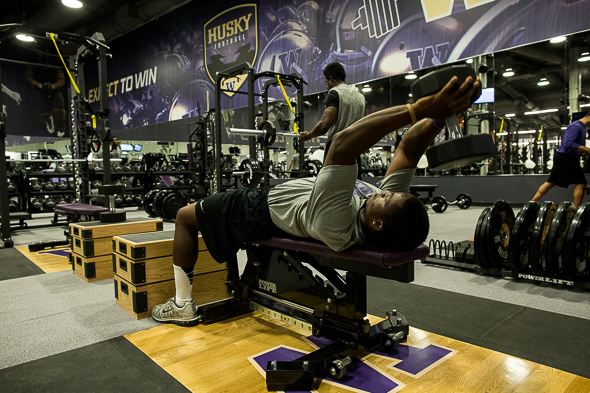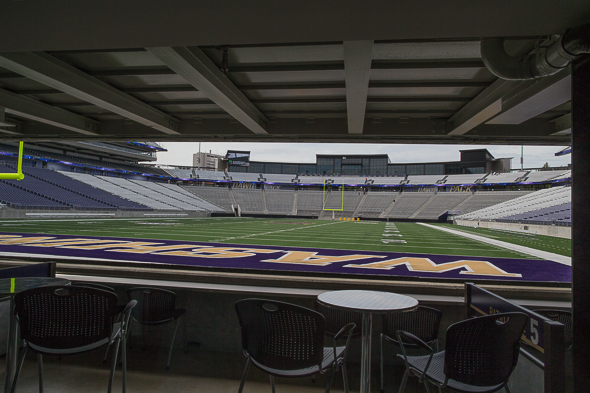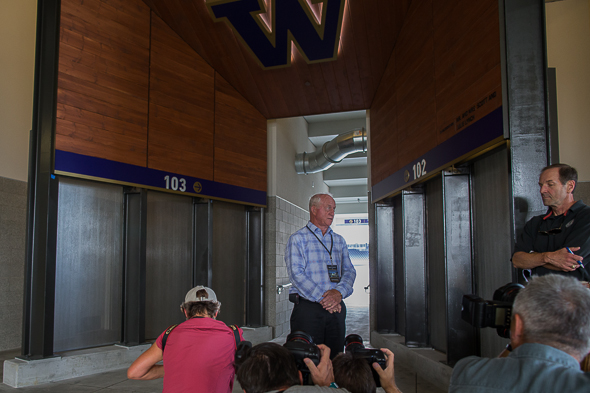
Something had to be done about Husky Stadium. If not, the University of Washington football program was going to further decay, possibly suffer unprecedented failure.
In 2004, Keith Gilbertson, already fired as the Huskies head coach with only the Apple Cup left to play, made this frank and rather startling assessment over dinner and drinks at a restaurant not far from the stadium.
“It’s going to be down for a long time because of the facilities,” Gilbertson said. “It’s going to be bad.”
It’s not clear if anyone at Gilbertson’s table that night actually believed him. After all, he was on his way out. Things were bad enough already for the Huskies, with a disastrous 1-10 season nearly in the books.
Nine years later, after everything Gilbertson said came true, leading to the darkest, most depressing period in UW football history, a new Husky Stadium rises majestically out of the ground.
By all accounts, what the school will unveil for Saturday night’s season opener against Boise State is a marvel in college football stadium construction. Many an amenity is in place with a far stronger connection to the program’s glorious past.
School officials will tell you that years earlier, Husky Stadium reached the point of no return, where it had to be fixed and upgraded. For $280 million — about $30 more than budgeted, but about 70 percent of the original renovation estimate — all of that was accomplished.

What they won’t necessarily trumpet, because it only needs to be inferred now, is the horrific downturn — seven seasons with neither a bowl game nor a winning record and precious few NFL-bound players — won’t happen again. The new place was built to win.
“With a great year and that facility, you’ll see tremendous recruiting classes near the top of the league and a very strong tradition — a return to Husky football,” said Ron Crockett, one of the school’s leading donors. “You had to have a facility to do it. I think there is the belief that it’s time to be great.”
Standing in the middle of the field, even in an empty stadium, the newfound intimidation factor radiates from the decks, bowl seats and walls far closer than before. Seating was moved 30 feet closer to the action. Imagine that, a crucial 10-yard gain already. The new sound system is akin to those used in arena concerts. The video screens are state of the art with a giant east-end scoreboard, two smaller west-end scoreboards and wraparound information ribbons built into the two decks and end zones.
“It was old. People are a lot bigger now than they were in the 1920s. It’s fan-friendly now,” said Don James, the Huskies’ most successful football coach (1975-92) and a stadium remodel committee member. “There were things I wasn’t even sure they could get done. Everything is better. Getting the track out of there was a big thing.”
Tapping its big-money supporters, most happily willing to pony up, UW installed 30 private suites (all but two are sold, $10,000-$15,000 donation per) and 2,500 patio seats in Club Husky (sold out, $1,050-$1,950 donation) in the four layers of the new south deck, and a dozen field-level suites in the 86-person Touchdown Terrace (sold out, $10,000-$15,000 donation) in the east end zone.

In the north deck, the 560-seat Don James Center (sold out, $32,500-$65,000 donation) has been remodeled inside. Black, padded theater seats are in on the exterior. Eighty seats were added to the section. In fact, every seat surface in the stadium is new.
And for the first time, Husky Stadium has a liquor license.
The students were displaced from sideline seats to the west end zone, a move that initially wasn’t well-received, but efforts have been made to appease them. They have their own stadium entrance, fronted by the Husky dog statue that once held sway in front of the basketball arena. “Path of the Pack” is marked in gold lettering and gold metal lines guide people through the entrance. The entry foyer overhead is covered in purple and gold mylar confetti that move in the breeze, commemorating “The Wave,” the infamous fan cheer that supposedly originated in Husky Stadium.
Coaches’ family members will have their own enclosed seating area in the west end zone directly above the students. Flanking each side of the west end-zone seating area are concourse event decks with panoramic views. A cell phone tower has been installed at the northwest corner outside the stadium to accommodate fans’ tech needs.
Heritage Club seats, which replaced the previous student section, are between the 30-yard lines on each side of the stadium, marked in purple. They represent the stadium’s most expensive ticket in face value ($184 for certain games, plus donation).
Capacity is listed at 70,138, down from 72,500 in the previous configuration. Season-ticket holders currently number 46,073, down from the high of 50,000 during the James era, but an increase over a drop to 39,000 during the program malaise.
“It wound up far better than any of us who sat on the committee for eight years thought it would,” Crockett said. “The proximity to the field is just amazing. For 80 years, the front-row seats were rotten seats. All you saw was the back of a helmet. With a 4½-foot rise, it’s just amazing. After the first game, when people see what’s there, there will be other season-ticket sales. It’s just too good.”
A ring of honor has been created outside the stadium, with banners holding the likenesses and names of former All-America players, Pac-10 players of the year and Rose Bowl most valuable players and college football hall of famers. Ten banners have been raised out of 23 that eventually circle the stadium. Great irony in one: It’s dedicated to Billy Joe Hobert, the starting quarterback who was banished from the program in 1992 for NCAA violations. Splashed across an inside south-deck facade, the UW’s 1960 and 1991 teams are recognized as national champions in large purple letters.
Concourses have wood paneling and Northwest-themed murals. Seven hundred TVs hang throughout the stadium. Elevators have been increased from two to 11. Restrooms have increased two-fold and all are modernized. A new press box is built at the top of the south deck, set back rather than hanging precariously over the seats, which made more than one visiting media member nervous. A separate national TV press box is on a lower level.
“It is off the charts,” said Tim Cowan, former Huskies quarterback, of the overall stadium upgrade. “It’s absolutely incredible. I don’t think there’s a better place in America than what we have here. There is no place like this on earth. I think the kids out there understand the opportunity they have to be great. That’s cool.”
Contractors suggested using all available stadium space, and created a 200-car parking garage inside the new south deck for premium ticket-holders. The UW Medicine Clinic, at $11 million part of the additional cost beyond the original $250 million budget, will lease new offices there, helping defray stadium costs. TV production trucks will park inside as well and have access to plug-ins, no longer needing 100 feet or more of cable to become operational.
What most fans won’t see are the elaborate coaching offices, locker rooms, meeting rooms, weight room and training room built inside the west end-zone entrance and beneath the seats. Coaches can practically live in their new workplace, with their own kitchen, shower and couches. Murals of past Husky moments and players cover the walls. Two barber chairs and a barber pole are among the touches. It’s not as gaudy as the University of Oregon’s new team offerings that created some national controversy, but it’s not far off.
UW players still enter the field through the longstanding tunnel, but will walk only 50 feet of it because of the new locker-room location — just a quarter of the previous distance from the old locker rooms in the basketball arena. They won’t have quite the emotional run-up to the field as before. Nor will they encounter their opponents in these tight quarters, which sometimes led to fights. Visiting teams will be housed inside the south deck and enter the field from the opposite end of the stadium in locker rooms much more modest than the Huskies’ lavish digs.
New turf covers the field. The midfield crown is gone. All decals, which include large W’s, the Pac-12 logo and the end-zone identifiers “Washington” and “Huskies,” are sewn into the turf, though a school official said if the team ever hosted a league championship game the necessary lettering would need to be spray-painted.
“I was really impressed to see everything new,” said James, who was wide-eyed in taking in all of the upgrades. “I’m happy for them. I think back to ’75 when we were happy to be here and happy to be in the Graves Building. Our position coaches met in the hallways. Now all of the position coaches have their own meeting rooms.”

Gone is the oversized UW helmet car, donated to the Museum of History and Industry after the track was removed and lost its place to run. Also gone is a championship plaque dedicated to the 1991 co-national championship team (it will get a new home, likely out of view). The statue of former Huskies coach Jim Owens has been moved to the northwest corner outside the stadium, facing toward it rather than greeting approaching fans.
Discussions on remaking Husky Stadium began in 2005, a year after Gilbertson’s gloomy pronouncement, and were led by former athletic director Todd Turner. He initially unveiled building plans that cost more than $400 million. He got a lukewarm response from donors, then the economy and UW football team began to tank together.
Turner’s replacement, Scott Woodward, was much more effective in hammering home the need for a new Husky Stadium. His timing was better, too, because construction costs had bottomed during the 2008 recession, when he stepped up his pitch. He also hired a new coach in Steve Sarkisian, and the program seemed to stabilize.
Woodward , who came to the UW from Louisiana State University with president and UW grad Mark Emmert, is now given nearly all of the credit for getting things done among donors. His personality was different than Turner’s and his approach more persuasive.
“The thing I liked about Scott is he’s a business guy,” said Dave Rost, another longtime donor. “Scott is persistent and he listens. They tried to do one thing and it didn’t work. When things didn’t work, they regrouped. It’s going to be tough to come up and play in this place. Everything’s looking up. I get goose bumps when I drive by.”
Some donors now fear Woodward might feel he has accomplished all he can do at the UW and look for a new challenge, such as becoming a conference commissioner. Already, Woodward lost his right-hand man, O.D. Vincent, senior assistant athletic director who had football responsibilities. Vincent, former UW golfer and UCLA and Duke golf coach, will leave soon and become tournament director for the PGA Tour’s Northern Trust Open, formerly the Los Angeles Open.
Unfinished is a pedestrian overpass above Montlake Boulevard. But that is a Sound Transit project, part of the commuter light-rail line and station that will bring fans to the stadium by 2016. The south-end lot parking is still consumed temporarily by the construction, leaving minor donor grumbling. Also left incomplete in the stadium are some finish details, but none that affect game-day operations.
Everyone will get a first look at new Husky Stadium Saturday night. So much has improved for the game-time atmosphere that there is a growing sense UW should seldom lose at home — similar to elite programs at Alabama, Ohio State, LSU, Michigan and Oregon.
Certainly a stadium-unveiling victory over Boise State is expected to set the tone for future games, if not coming seasons. Donors didn’t spend all that money up front (at least $50 million, while $200 million came from university-backed bonds) to see the home-field advantage by the lake further compromised.
Sarkisian, in his fifth season in Seattle, has put the program on solid footing, but not yet back among the best. He appears to have the resources, if not increasing talent, to do it now. The place was built to win. A home loss will be rare, if not unacceptable, this weekend.
“I don’t want to say any game is a must-win, but this is a must-win game,” James said. “I really think it is.”


16 Comments
And you didn’t even mention the best part about the entire project: no tax dollars used.
I wonder if Steve Ballmer and Chris Hansen will be in the new stadium this weekend to see how it should be done.
A football stadium for a college that’s been here for a century is different than a couple billionaires trying to get help to bring back an NBA team after said league vowed never to return to Seattle. Can’t compare.
Right, because the NBA is a private, for-profit business, which should be 100% privately-funded. So, while a public school like the UW might have some claim to tax subsidies, the NBA has absolutely ZERO right to expect any tax subsidies for their private, for-profit business.
It’s true that they had zero right to expect subsidy, but they did ask, and most markets capitulate. Seattle didn’t in ’08, and lost the team. Which was all right with a majority of Seattle taxpayers. The ask this time is to use the city’s cheaper bonding capacity, which is a contribution of civic assets, but not a tax subsidy.
You keep making the same mistake over and over again.
The city would use TAXES — property tax, sales tax, admission tax and B&O tax — to pay off the bonds that the city would sell for the new arena. In exchange, Hansen/Ballmer would pay only about $1 million per year in rent.
That is a TAX SUBSIDY: the city uses taxes to pay for a facility which they rent to Hansen/Ballmer for pennies on the dollar. TAXES will be paying off the bonds, instead of RENT from Hansen/Ballmer paying off the bonds.
Hansen was even quoted in a column you wrote saying “Make no mistake about it, we getting our taxes forgiven,”
https://www.sportspressnw.com/2130671/2012/hansen-part-2-this-arena-is-not-a-hobby
What about that is difficult for you to grasp? How is “getting our taxes forgiven” not a “tax subsidy”?
what happened to the statue of the husky dog in front of the stadium we always patted his head
But both entities tried to hit up the same Legislature for funding, and went nowhere. So yes, you can compare.
what happened to the husky dog statue infront of the stadium
No doubt that the tax-free nature of this project makes it all the sweeter. Too bad they didn’t think of self-funding sooner.
From the photos the place looks great and I hope the Huskys do it proud … but there’s that new football palace in Eugene that’s eye popping, excessive and certain to attract 18 year old recruits.
That’s why they call it the arms race. Ducks have Brazilian mahogany, Huskies have Seattle, compared to Eugene.
On the statue of Jim Owens–it’s not so much that he’s facing Husky Stadium–he’s facing toward the Rose Bowl.
There should also be a statue of the Dawgfather.
Owens and ans will be doing a lot of squinting to see the Rose Bowl with this team.
And James will get his due. One thing at a time.
Love the new concession area. Used to be even even the old Crest movie theatre had better concessions than Husky stadium. They should move the video screen to the other side of the stadium so as to show off the view, but I’m wondering if eventually a bigger one might be installed in addition in the other end.
Stadium regulars will be dazzled by concessions, and probably shocked at prices, but that’s the cost of the big time.
The east scoreboard is surprisingly unobtrusive, mostly because of the immense panorama behind it.
You mentioned the new cell tower in the NW corner of the building. I have major complaints about the cell service in the building. I was at the game on Saturday night, and had no Sprint service whatsoever inside the new digs. Buddies of mine with Verizon and T-Mobile all had the same issues. This one really needs to be addressed…I overheard many similar rumblings while walking the concourse at halftime.